YouTube SEO: 8 Simple Steps For Top-Ranking Videos 


YouTube SEO? That’s right; YouTube has entirely evolved since its first launch in 2005.
According to the video platform, nearly one-third of internet users are now turning to YouTube to discover, consume, and share video content.
How much video content are users consuming exactly? Over 1 billion hours of YouTube videos a day. That’s more than Netflix and Facebook video combined!
Meanwhile, your business is creating videos tailored specifically to captivate and ultimately convert this hungry audience.
How do you make sure your videos are ranking up there for your audience to discover? How do you get your content to appear at the top of search rankings and even in suggested videos?
That’s where YouTube SEO comes in.
Because of the sheer volume of switched-on users, YouTube’s search algorithm has adapted, and now you can optimise videos for YouTube search, just as you’d optimise other content for Google.
In this blog post, you’re going to learn actionable and straightforward SEO tactics to get your videos ranking on YouTube for the long term and how you can make sure your videos appear for relevant YouTube search queries.
What is SEO for YouTube videos?
To successfully optimise your YouTube channel using SEO tools, it is vital to precisely understand what YouTube SEO strategy is all about.
Essentially, YouTube SEO is the process of optimising your YouTube channel, playlists and videos to rank highly for a given keyword search query in YouTube’s organic search results.
SEO for YouTube videos can also assist in elevating you in search engine results pages, helping marketers to move swiftly up the Google rankings.
How YouTube’s search engine algorithm works
In the YouTube creator academy course, YouTube describes their search engine algorithm:
‘Videos are ranked based on a variety of factors, including how well the title, description, and video content match the viewer’s query. Beyond that, we look at which videos have driven the most engagement for a query and make sure it’s easy for viewers to find those.’
Rather than focusing on what videos the algorithm likes, YouTube suggests creators should base their SEO strategy on what the audience likes.
Creators can analyse this by evaluating the following characteristics of their audience:
- What YouTube videos they watch
- What videos they don’t watch
- Watch time
- Audience retention
- Likes and dislikes
- ‘Not interested’ feedback from respondents
Focusing on the visitors to a YouTube channel page holds the key to high video rankings and audience engagement. High engagement is ultimately the critical ingredient to effective YouTube video SEO.
Now we understand how the YouTube algorithm works, let’s look at some YouTube SEO tips and best practices to take your YouTube channel to the next level.
Steps to optimise for YouTube SEO
1. Do keyword research, but on YouTube
Think of YouTube as a video search engine. This means creating and optimising content for YouTube requires keyword research, just as you would do for Google search or Bing.
It’s all about understanding the intent behind every search query and providing a relevant and high-quality piece of content that answers that query.
Your YouTube keyword research aims to find out what your audience is interested in and how they talk about it online.
There are a few different ways you can conduct keyword research.
Use the YouTube search bar
Start on YouTube and type a seed keyword in the search box (think of this as your starting point or head keyword, which can be expanded on later). As on Google, while you type, YouTube will auto-generate popular searches via the autocomplete feature:
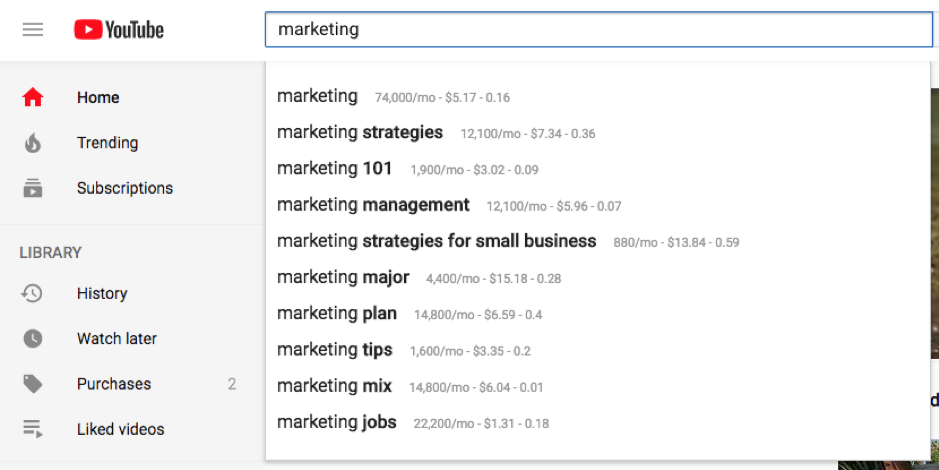
Source: HubSpot YouTube for Business
These are actual phrases YouTube users are searching for.
Then, use Google Keyword Planner to check how much monthly search volumes those keywords get.
Ideally, the video keywords you land on should get a few hundred monthly searches.
Google Trends
Another excellent keyword research tool to use is Google Trends. Head to the YouTube search option for YouTube-specific search volume data. Use the percentages to compare keywords to see which are being searched for more frequently.
PRO TIP: Put the target keyword in the video file name.
The first thing you should do with your target keyword is to put it in the video file name. YouTube can’t “watch” your video to see how relevant it is to your target keyword, but it can read your video’s file name and all the code that comes with it when you upload.
For instance, if your video keyword is “how to build a deck”, your video file name should be “how-to-build-a-deck.mov”.
2. Create high quality, high retention video content
Here’s the thing you need to know about YouTube viewers. Unlike on other social media channels, users are not mindlessly scrolling through videos. They use YouTube for entertainment or help. They are actively watching videos.
How do we know? Because YouTube says:
95% of time spent watching YouTube videos is in full-screen and with the sound on.
What does this mean for your videos?
It means you need to focus on creating high-quality videos people want to watch.
This isn’t any different from the rest of your content. When you are optimising your articles for Google, you are actually optimising them for users. The same applies to videos.
That means (like any other channel) the focus should remain on quality over quantity.
You have three options here:
- Hire a freelancer to produce videos for you
- Hire a dedicated video agency
- Do it yourself
If you choose option C, you’ll need to invest in some proper equipment. Yes, you can produce some great videos on your smartphone these days, but you’ll still need some editing software, microphone, lighting and tripod.
For example, sportswear brand Brooks has lots of beautiful professionally-shot videos:
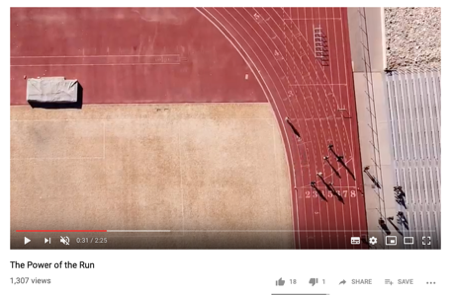
They also post a heap of low-budget videos of employees describing shoe features:
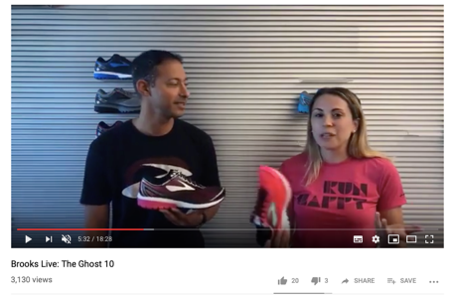
Both types of video are equally useful and valuable to the brand’s audience. But why should they invest more in the shoe description videos when they can get a similarly good result on a budget?
Video length
Another consideration here is the video length.
Many experts will tell you that longer videos perform better on YouTube.
Why? Because one of the most important ranking factors in SEO is TOTAL WATCH TIME.
The longer people spend watching your video, the better your video tends to rank. This is what we mean by high audience retention.
BUT – and it’s a big but – longer videos may not work for your audience.
If you don’t have enough valuable content to fill 10 minutes, don’t make a 10-minute video. People will get bored and click away – which won’t be good for your ranking.
You only know what works by watching what the competition is doing, testing and measuring your results.
3. Step up your video production value
With so much competition in the video marketing ecosystem, it is crucial that channel owners create high-quality video content with premium production values.
SEO can be understood at its essence as the optimisation of the user experience. That being said, no matter how thorough your keyword research may be, without quality content, you will lose your audience, thereby thwarting your SEO efforts.
Therefore, for creators making their own videos, the production value is vital in audience retention.
While not everybody can afford an expensive, pro setup, there are affordable options for beginners through experienced professionals.
With an iPhone or Android phone, all you need is a few added extras to take your YouTube videos from zero to hero.
Here are some products we recommend to help you optimise your videos for optimum user experience.
Get a tripod
A tripod is one of the quickest and cheapest ways to up your video production qualities. A little stability really does go a long way when it comes to quality video content.
Invest in a backdrop and lighting
A backdrop can be as simple as a homemade solution, like a sheet draped over a clothes rack, or as sophisticated as some of these options from Amazon.
Good lighting is an integral part of production when it comes to YouTube videos.
As with the above elements, your lighting can be straightforward- a few home lamps positioned correctly will suffice.
If you do have the budget, there are some very affordable options out there for video creators.
Get a microphone
Perhaps the most important piece of equipment to invest in to up your video production value.
Mics range significantly in cost and quality, but you won’t regret making the investment if you can afford a high-end microphone, lapel mic and adaptor.
4. Write an engaging, informative video title
Anyone who’s ever done SEO for Google knows the importance of optimising headlines. The same rule applies to YouTube SEO.
The title of your video is arguably the most crucial factor in your YouTube SEO. It dramatically affects your click-through rate (CTR), as it appears in the most prominent place on the YouTube search results page.
The absolute must-do tip for your title is to make sure the title closely matches what the viewer is searching for.

This is something that YouTube explains:
“Videos are ranked based on a variety of factors including how well the title, description, and video content match the viewer’s query.”
At the same time, keep it clear and concise – your audience should know instantly what the video will be about.
The bottom line – if more users click on your title than on your competitors, it tells YouTube that your video is a good match for the keyword.
Also, shorter is sweeter. HubSpot campaigns manager Alicia Collins recommends under 60 characters to keep the title from getting cut off in results pages.
Moz confirms this with research, saying that titles of less than 50 characters actually perform better.
5. Optimise your YouTube tags
Tagging is one of the best YouTube SEO tools that you can use to optimise your videos.
The tagging function allows creators to enter relevant keywords that help videos get more views.
This is an excellent opportunity to use a keyword research tool to discover and use LSI keywords.
LSI (Latent Semantic Indexing) keywords are terms that are related to a main keyword and are seen to be semantically relevant.
However, whether you decide to tag your video with seed keywords, long-tail keywords, or LSI keywords, it is crucial to choose highly relevant keywords to your video. Also, keep in mind that less is more here; 10 to 12 tags is more than enough to enhance your SEO.
6. Include your target keyword naturally in your title
Once you have used keyword research tools, such as a keywords explorer or keyword planner, to find the optimum keywords for your videos, you not only need to write an engaging video title, you need to ensure that it includes the target keyword naturally.
Your title is one of the most critical elements that YouTube has to work out how your video is related to a particular keyword.
By including your keyword in the title, you’re making it easy for YouTube to rank your video higher.
Backlinko’s research shows that videos including the exact keyword once in the title will perform better than those without.
Preferably use it at the beginning of the title, and try to do it in a natural way.
For example, if you want to rank the word “accounting software”, do what Xero has done.
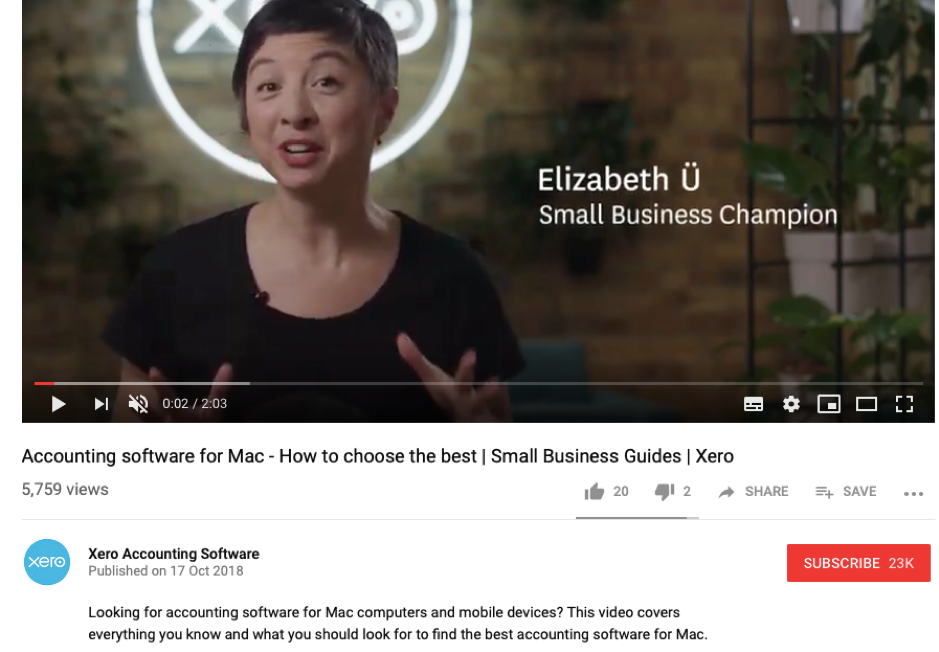
7. Optimise your video description
Your video description is the only place you can get into the details and describe what your video is about.
According to Google, the official character limit for YouTube video descriptions is 1,000. But let’s be real – your viewer clicked on to watch a video, not to read an essay.
If you do go for a longer description, remember that YouTube only displays the first two or three lines of text (about 100 characters). Then, viewers need to click “show more” to read the rest. That being said, a video description of more than 250 characters is optimal.
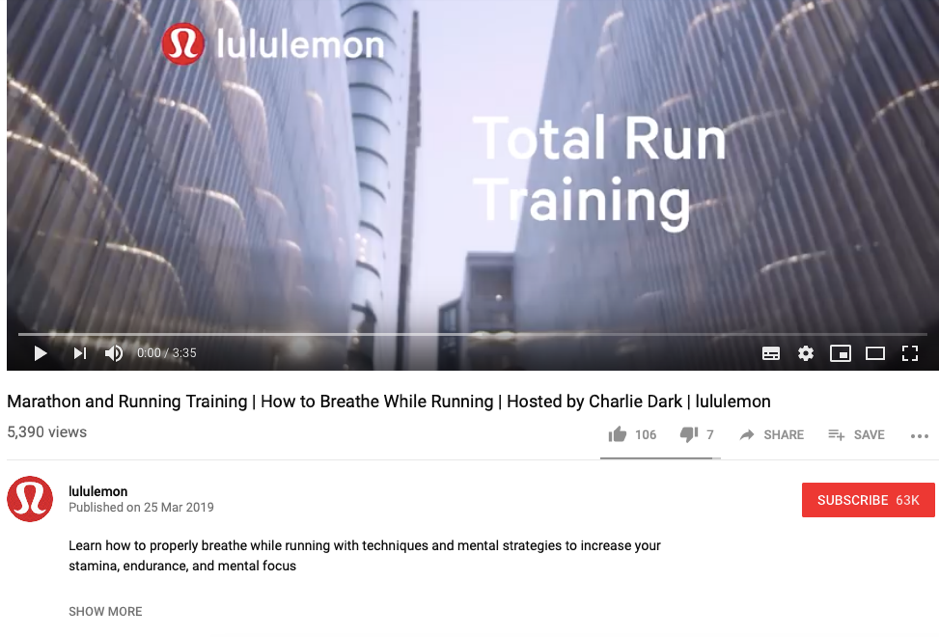
Here’s what you get when you click for more:
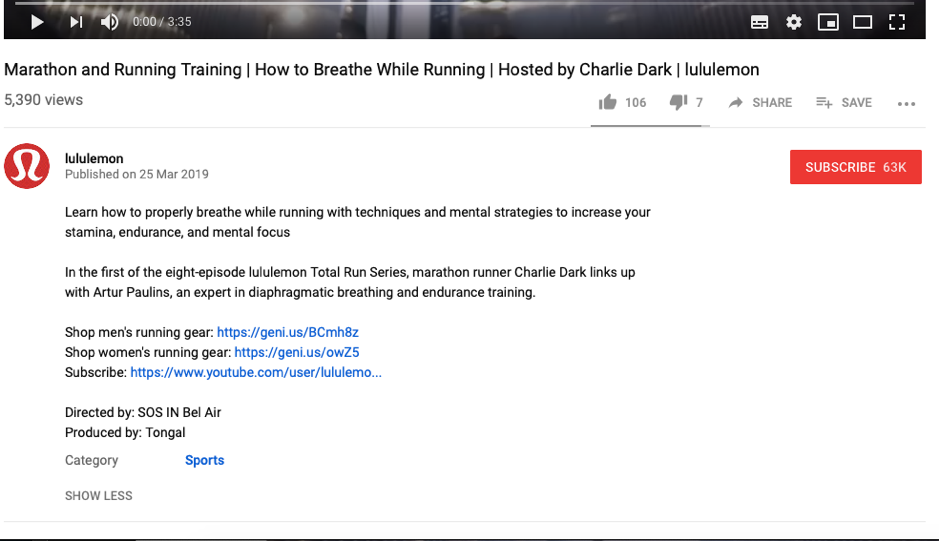
Our advice? Front-load the video description with the most essential information, including your target keyword, call to action and links.
In fact, add in your target keyword as early as you can, naturally. The critical word here is “naturally” – don’t crowbar it in.
YouTube’s bot will then see your keyword almost immediately and crawl it, which could result in a higher ranking.
Another great tactic for your description is to make it useful for viewers. For example, see what Hootsuite has done:
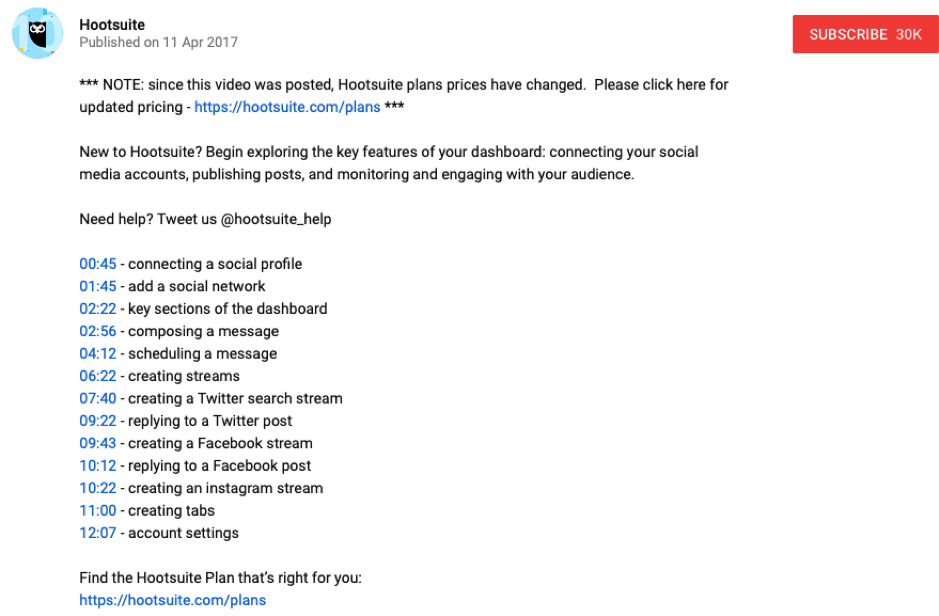
Hootsuite knows not everybody needs to sit through the whole video, so they make it easy for viewers to skip to the bit they are most interested in viewing.
The Youtube Creator Academy suggests the following best practice when writing your video description:
- Ensure each video has a unique description
- Use the first few lines of the description to cover the content of the video using natural language that includes your keywords.
- Use the rest of the text (what shows up once the user clicks “Show more”) to ask viewers to ‘like’, ‘subscribe’ and ‘comment’, along with all relevant social media links.
Furthermore, OMG suggests the following to take your video description to the next level.
- Put your link at the very top of the video (this maximises CTR to your site)
- Include your keyword in the first 25 words
- Make the description at least 250-words
- Include your keyword 3-4 times
- You can add a timeline of the video – to tell what topics were covered in the video and when
8. Implement video schema markup
Video schema markups are HTML tags that mark up your videos in a way that is recognised by search engines and is a proven way to optimise your videos.
Following schema markup best practice allows your videos to rank higher in SERPs and allows search engines to display a rich snippet- detailed information displayed with your search result- for your video.
If you’ve implemented video markup schema correctly, when users conduct a Google search, your result will show up with an image from your video, along with the title and description that you included in your schema, as you can see in the following image:

Google’s best practice guidelines for video schema markup include:
- Name. This required tag is the title of your video. Your title should be short and engaging and include a geo-specific keyword where applicable.
- Description. Another required tag is the description of your video. This is the text that will appear in the rich snippet in Google search results. Make it enticing to the reader, as this is a huge factor when it comes to CTR.
- Duration. This recommended element notes the length of your video. It is important to note this must be done in ISO 8601 format.
- ContentURL. Another element Google recommends. The ContentURL points to the video media file and should be in a video file format such as mp4, .wmv, .avi, .ram, .flv, .mpg, .mpeg, .mov, or .asf. These files must be accessible via HTTP as this allows Google to generate both thumbnails and video previews as well as verifying your video.
- EmbedURL. This recommended element is the URL that points to a player for your video.
- UploadDate. This is only recommended if you want your video to expire at a point in the future
Based on how you mark up your content using schema, your videos may also be eligible for the following video enhancements.
LIVE badge

Creators can get a LIVE badge by marking up their video with BroadcastEvent.
The LIVE badge can be applied to any video that is live streaming on YouTube such as:
- Sporting events
- Awards shows
- Influencer videos
- Live streaming video games
When marking up your live streams, it is vital that you follow the LIVE badge guidelines and use the Indexing API to ensure Google crawls your page at the right time.
Key moments
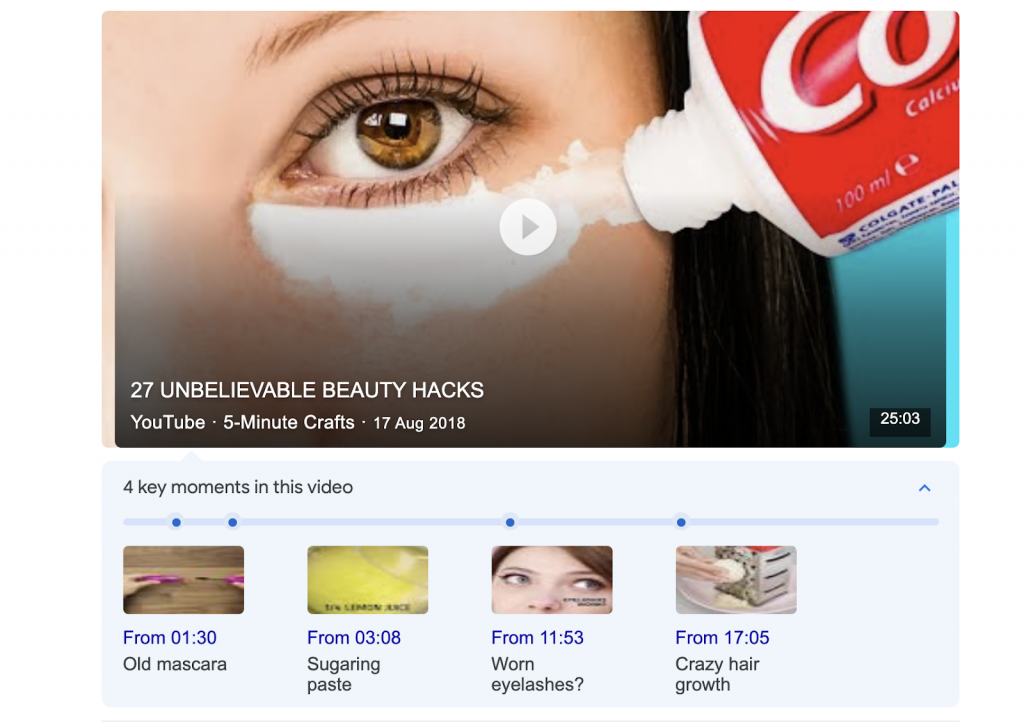
The “key moments” markup allows users to navigate video segments like chapters in a book, helping users to engage more deeply with your content, and allowing them to skip to key moments that are relevant to them.
While Google Search automatically attempts to detect segments in a video and show key moments to users, there are two ways that creators can manually tell Google about the important points in their video.
a. If your video is hosted on your web page
If your video is hosted on your website, you can add Clip structured data, to specify to Google the exact start and endpoints of each key moment and what label to display with each section.
b. If your video is hosted on YouTube
If your video is hosted on YouTube, you can specify the exact timestamps and labels in the video description on YouTube, by following YouTube’s best practices marking timestamps.
9. Create a custom thumbnail image
Make sure your YouTube channel and content have a cohesive visual identity. This helps to build authority, awareness, and familiarity.
Check out Bupa Australia’s channel:
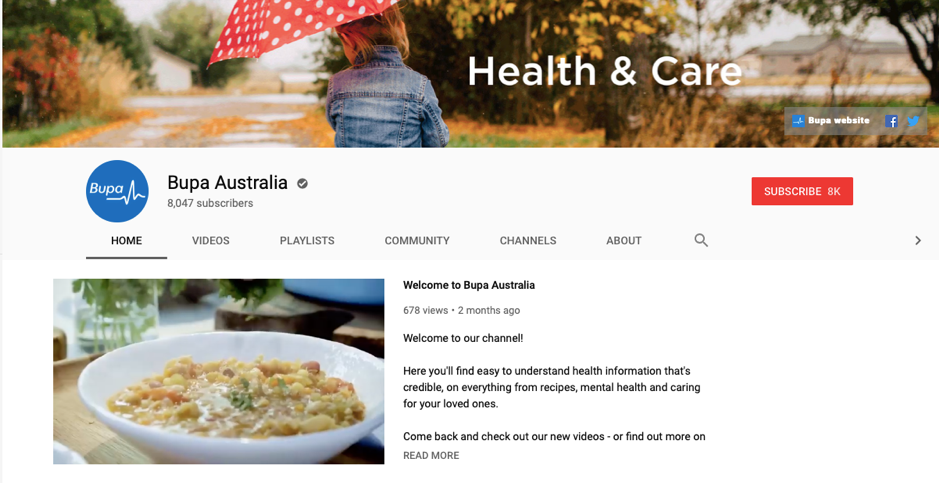
But most importantly, your visual identity also improves ranking.
How?
Thumbnails are often overlooked for YouTube SEO, but an appealing thumbnail image can actually help you get more clicks on your video. And the higher your CTR, the higher YouTube tends to rank your videos.
Use these tips for your thumbnails:
- Customise your thumbnail image with words
- Don’t be obscure – make it obvious what your video is about
- Ensure it is well-lit
- Don’t cover the whole image with your logo.
Check out the way Bupa keeps consistent thumbnails for its videos:
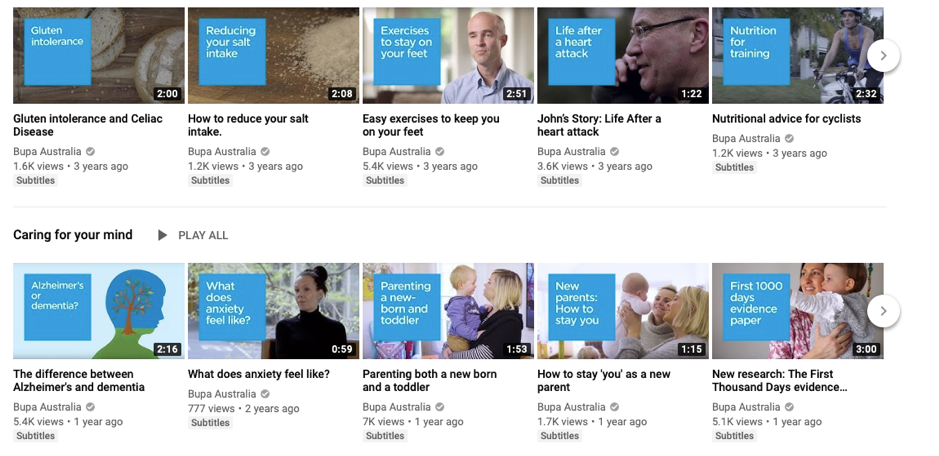
The thumbnails cleverly use words and high-quality images (photos or graphics) to grab your attention.
Another excellent example is activewear brand Lululemon:
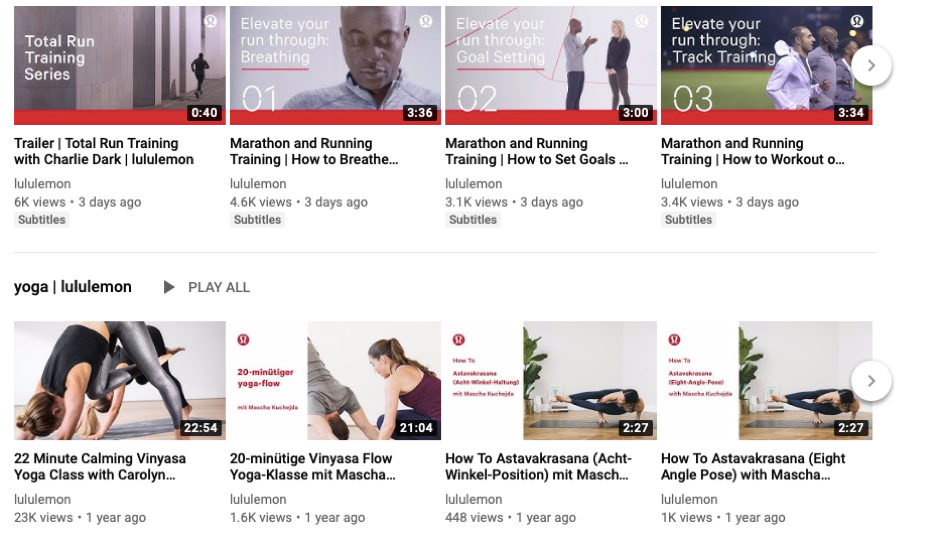
Don’t stress if you don’t have the budget for a graphic designer right now – try creating your own on Canva. If you are creating your own, the best approach is to keep it really simple.
10. Say your keyword
Saying the keyword in your video may seem like a strange YouTube SEO tactic. Mainly because YouTube doesn’t rank your videos by watching them.
But it does automatically transcribe your videos – and these transcriptions are crawlable by search engines and therefore will show up in video search results.
Closed captions
Transcribed videos rank higher since they allow access to information in multiple formats, depending on preference and need. You can increase your ranking by having your video captions or transcript translated and uploaded to translated subtitles on YouTube. You can learn how to do this with this Tutorial on Youtube.
It is also important to note that when you say the keyword around which your video is optimised, it will appear in your transcription and closed captions. YouTube will better understand that your video is about that topic and rank you higher as a result.
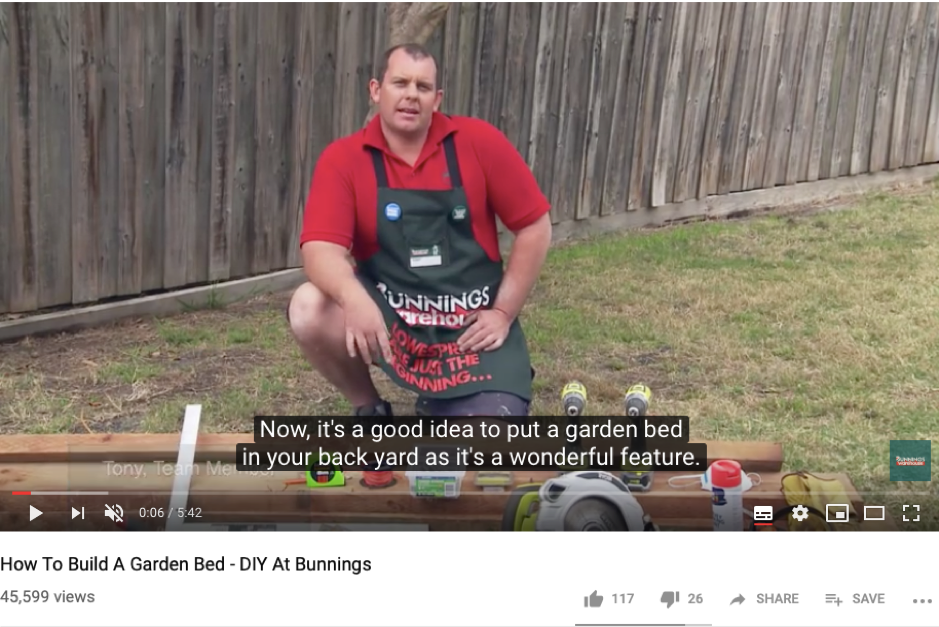
A quick tip on closed captions. While YouTube supports automatic captioning, it’s not perfect. So, we recommend you either edit the closed captions or even consider adding your own captions.
11. Share your video
While this may seem obvious, sharing your video is an integral part of gaining followers for your channel, and in turn, positively affecting your YouTube SEO.
Popular content with high views will always show up higher in the search results than its counterparts.
When sharing a YouTube URL via your various channels, creators should also consider sharing the playlist URL rather than the single video URL.
At the end of each playlist video, YouTube will automatically play the next video in the list. This helps increase your time-on-page and time-on-site metrics. If you have multiple videos you are looking to promote on social media platforms, make sure to share the complete playlist URL rather than the single video URL.
Social media engagement
The internet of today is inherently social and is driven by social media channels.
Cross-posting your content to Facebook, Twitter, LinkedIn, and Quora is invariably the most potent way to drive traffic to your channel for maximum visibility.
Twitter research shows that “Video on Twitter drives engagement”, with YouTube shares on Twitter being far higher than the number of uploaded native Twitter videos.
For creators in the business field, LinkedIn is possibly the effective platform when it comes to creating visibility for your YouTube channel. LinkedIn users tend to be more engaged than on other media. Furthermore, adding your videos to LinkedIn will help boost your LinkedIn profile, adding credibility. Double win.
Quora is often a rarely thought of platform to post on, but it can be one of the most effective. This is because people on Quora are looking for answers to specific questions. If your video can answer this question, you will be targeting people that are more than likely interested in your channel.
Email your list
Your email list is one of the most vital tools in your marketing arsenal.
Every time you post a new video, send a quick newsletter to your list, including the new content.
You can also consider placing a link to your latest video in your email signature like Brian Dean has here:
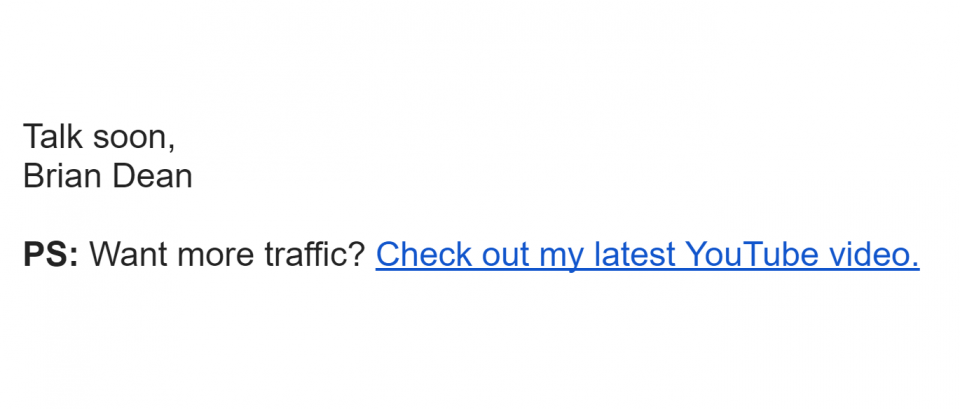
Embed videos on your website
It goes without saying that you should also embed your videos into your website, blog and any other marketing channel you are using.
12. Encourage people to subscribe
Engagement is a MASSIVE ranking factor for YouTube. Just like Google, YouTube looks for content that’s popular and relevant.
So, how can it tell what videos people like the most?
User interaction signals
In other words, all those things that people do to interact with your video: liking, commenting, sharing and subscribing.
User comments give your video more relevance and authority in YouTube’s eyes. They show YouTube that people are engaging with your video content.
When Backlinko analysed 1.3 million YouTube video results, it found that comments strongly correlated with a high ranking in the search results:
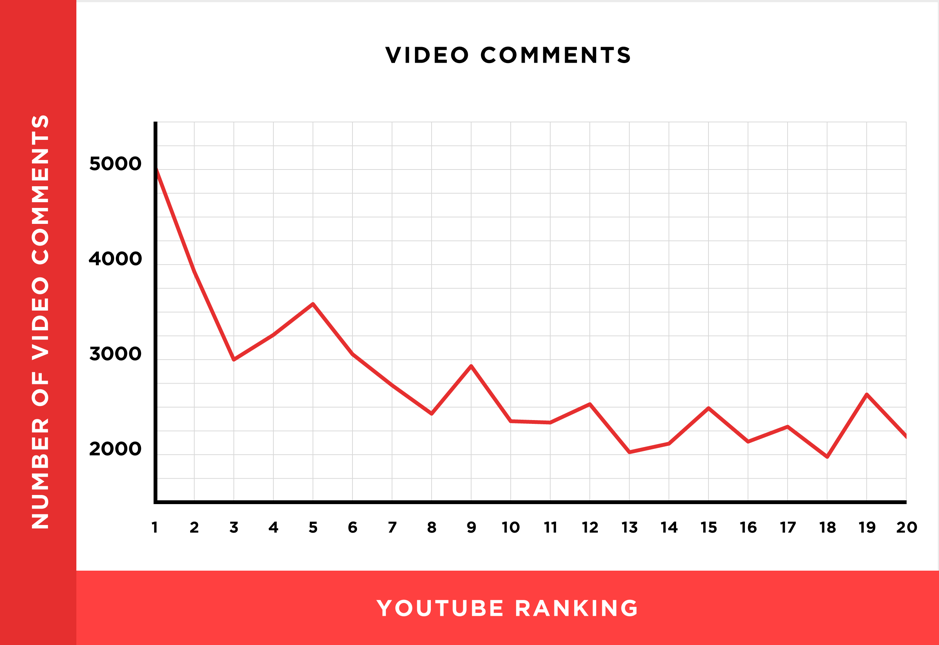
Source: Backlinko
If you think comments are great, subscribers take this to a whole new level.
Subscribing means that people like your content enough to want to watch it regularly. You’re providing them with VALUE, and that’s a powerful thing in YouTube’s opinion.
That’s why YouTube uses subscriber numbers as one of its ranking factors.
So, encouraging engagement should be an integral part of your YouTube SEO strategy.
Ask Subscribers to Comment and Like
To create this engagement, you should be actively doing just that, engaging with your audience.
Use this actionable checklist to encourage user engagement and retention:
- Gain more comments by responding to user comments and keeping the conversation going.
- Reach out to users via comments and ask them to subscribe to your channel.
- End your video with a question to kick-start a discussion.
- End your video with a call to action to Subscribe, like Brian Dean from Backlinko:
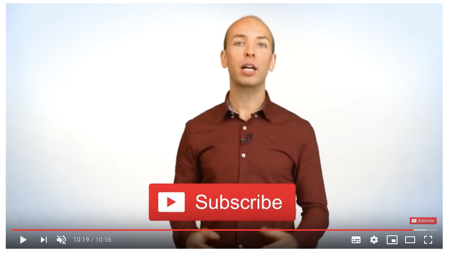
Hootsuite does a great job of responding to viewer questions and comments:

Even if they are just acknowledging the comment with a thank-you:

This is where your video quality comes into play. If you create awesome videos, you won’t be afraid to ask for comments!
13. Increase Your Watch Time
Watch time is a critical Youtube ranking metric. Watch time is quite simply the amount of time viewers spend watching your videos, and there are several ways you can improve this for higher rankings by understanding when users typically drop off.
Review your Watch Time Report
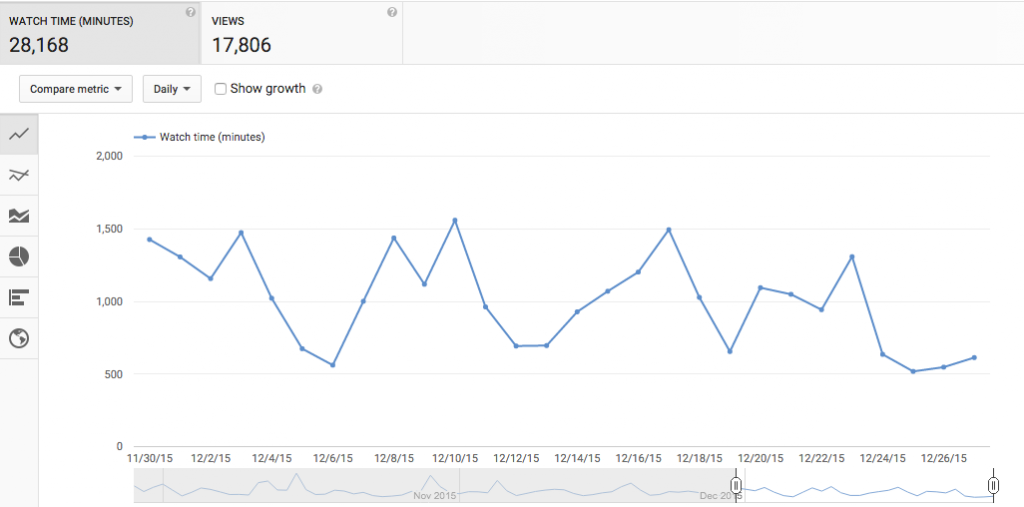
Just like Google Analytics, YouTube offers excellent analytics reports to inform your content marketing strategy.
Creators can use the watch time report to identify what videos are landing with their audience and when people are switching off.
To access the watch time report, go to YouTube Studio.
In the menu on the left side, navigate to Analytics, then go to Watch Time.
15. Use Engagement Reports to Drive YouTube SEO
Analytics reports are one of the easiest and most practical ways you can inform your content marketing strategy.
YouTube provides channel owners with several different engagement reports along with a thorough guide on how to use analytics to optimise your videos.
From the Subscribers report, detailing how many subscribers you’ve gained or lost, to the Average Percentage Viewed report showing what percentage of your videos are viewed before users switch off, creators should be regularly scouring these reports for valuable insights.
Time to get to work
Now you know how to do YouTube SEO, it’s time to put these strategies to work.
And this only scratches the surface!
YouTube is experiencing massive growth in terms of user engagement, which makes it a brilliant place for brands to grow.
Get onto YouTube and start testing out what works. Only through trying and testing will you find out both what works now and what will work in the future, as algorithms change and competitors expand.
YouTube is only one channel where you should be focusing your search engine optimisation efforts. Find out what else you absolutely must be doing with your Free SEO Audit by one of our Growth Gurus.
Best of all, there are proven strategies for generating tangible growth in your online presence — all featured custom to your business. Claim your game plan now!









